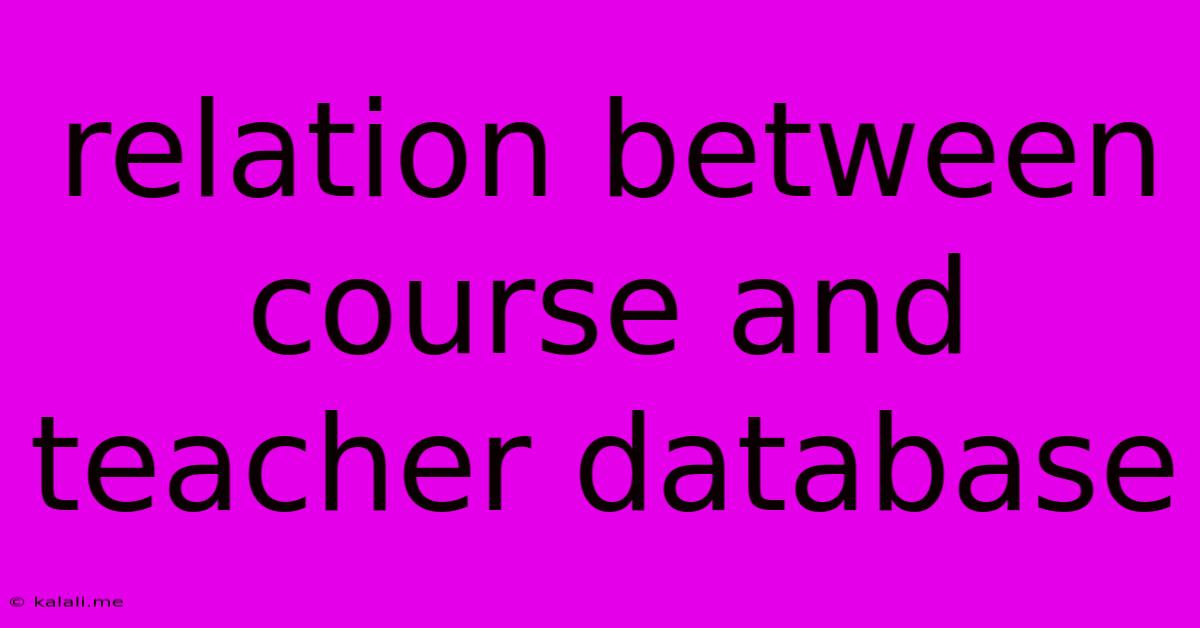Relation Between Course And Teacher Database
Kalali
May 23, 2025 · 3 min read

Table of Contents
The Crucial Relationship Between Course and Teacher Databases: Optimizing Efficiency and Data Integrity
This article explores the vital connection between course and teacher databases, highlighting the importance of a well-structured relational database design for efficient management of educational institutions. We'll delve into the key elements of effective database design, common relationships, and the benefits of a streamlined system. This will enable educational administrators to better manage course schedules, teacher assignments, and student records, ultimately improving the overall learning experience.
Understanding the Core Components: Courses and Teachers
Before diving into the relationship, let's define the core components:
-
Course Database: This database stores information about each course offered, including the course ID, course name, course description, credits, prerequisites, scheduled times, location, and the assigned teacher(s). Key fields often include a unique identifier (e.g., course code) and potentially a department ID for organizational purposes.
-
Teacher Database: This database contains information about each teacher, such as teacher ID, name, contact details, subject specializations, teaching experience, and potentially their availability. A unique identifier (e.g., employee ID) is essential.
Establishing the Relationship: One-to-Many and Many-to-Many
The relationship between the course and teacher databases isn't always straightforward. It often depends on the institution's structure and teaching methodologies. Two common relationships are:
-
One-to-Many: This is the simplest scenario where one course is taught by only one teacher. The teacher database would have a foreign key referencing the course database's primary key (course ID). This is suitable for smaller institutions or courses with a single instructor.
-
Many-to-Many: This is more complex and prevalent in larger institutions. One course may have multiple teachers (e.g., team-taught courses or courses with teaching assistants) and one teacher may teach multiple courses. To handle this, a junction table (also known as an associative entity or bridge table) is necessary. This intermediary table links courses and teachers, establishing a many-to-many relationship. The junction table typically contains the course ID and teacher ID as foreign keys, allowing for flexible course assignments. Additional fields might include the teacher's role (instructor, assistant, etc.) and the percentage of teaching responsibility.
Designing an Effective Relational Database
Several key considerations are crucial for a robust and efficient database:
-
Normalization: This process reduces data redundancy and improves data integrity. Properly normalized databases minimize inconsistencies and ensure data accuracy.
-
Data Integrity Constraints: Implementing constraints, such as primary key constraints, foreign key constraints, and data type constraints, helps maintain data accuracy and consistency.
-
Indexing: Appropriate indexing significantly speeds up data retrieval. Indexes improve query performance, particularly crucial for large databases.
-
Scalability: The database design should be scalable to accommodate future growth in the number of courses and teachers.
-
Data Security: Robust security measures are vital to protect sensitive information about teachers and courses.
Benefits of a Well-Structured Database
A well-designed relational database connecting courses and teachers offers numerous benefits:
-
Efficient Course Scheduling: Simplifies the process of assigning teachers to courses, minimizing conflicts and maximizing teacher utilization.
-
Improved Reporting: Enables the generation of accurate reports on teacher workload, course enrollment, and other relevant metrics.
-
Streamlined Administrative Tasks: Automates tasks such as generating teacher payrolls, creating course catalogs, and managing student records.
-
Enhanced Data Integrity: Minimizes errors and ensures consistency across the system.
-
Better Resource Allocation: Facilitates optimal allocation of resources based on accurate data and efficient reporting.
Conclusion
The relationship between course and teacher databases is fundamental to effective educational administration. By carefully designing a robust relational database, incorporating appropriate relationships, and implementing best practices, educational institutions can optimize efficiency, improve data management, and enhance the overall learning experience for students and faculty alike. Understanding the nuances of one-to-many and many-to-many relationships, along with the importance of database normalization and integrity, is crucial for success.
Latest Posts
Latest Posts
-
How Long Does It Take To Bleed Brakes
May 23, 2025
-
How To Get Rid Of Frogs In Pool
May 23, 2025
-
User Not In The Sudoers File
May 23, 2025
-
Which Mice Poison Are Mice More Attracted To
May 23, 2025
-
How To Update Rhel Minor Version
May 23, 2025
Related Post
Thank you for visiting our website which covers about Relation Between Course And Teacher Database . We hope the information provided has been useful to you. Feel free to contact us if you have any questions or need further assistance. See you next time and don't miss to bookmark.